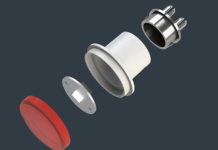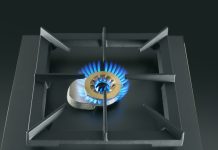The use of innovative materials in the various industrial fields, from automotive to household appliances and electronic products, is arousing designers’ growing interest. In that context, thanks to the most recent developments, today plastic materials play a role of absolute relevance.
Roberto Papeschi

In the past metal was the absolutely prevailing element in the production of the most widely known durable goods, from cars to household appliances, starting from the Seventies the situation has progressively changed in favour of plastic. The needs of minor environmental impact, higher energy saving and better product performances have in fact led industry to research eco-sustainable, lighter and more performing materials. These conditions have favoured the use of innovative materials able to replace those commonly used until that time: cast iron, steel, brass and aluminium.
The automotive industry has played a driving role for that. This fact has occurred due to the changed market conditions that have resulted, in the automotive industry, in the need of reducing the vehicle consumptions, urged by ecological reasons that have given birth to the trend of a general decrease of the weight of vehicles themselves, obtainable with the use of plastic elements replacing metal parts.
Such a substitution has been enabled by the contemporaneous developments of the chemical industry that, from the Fifties onwards, has implemented a range of important innovations, some of which absolutely revolutionary. The result was to make available for the industry numerous and different plastic materials characterized not only by reduced weight but also by high characteristics of mechanical and thermal resistance and by easy workability. The moulding production process, typical of plastic materials, allows in fact achieving structurally complex elements in economic way, permitting an integrated design of technical elements and greater shape and colour freedom in the product design.

A century of history
If it is true that the plastic industry began at the end of 1800, with the production process of celluloid that can be considered the first plastic material produced by man, the true century of plastic is the twentieth century, starting from 1910 when the Belgian chemist Leo Baekeland patented, with the name of Bakelite, the first thermosetting resin of synthetic origin obtained by condensation between phenol and formaldehyde. The new material was very successful and became for several years the most diffused and used plastic material for the manufacturing of the most different products. Since then, numerous other materials have been introduced on the market, from polyvinylchloride (PVC) to cellophane, a cellulose-based flexible and transparent material.
But it is in the Twenties and in the Thirties that the passage of plastic to the adult age takes place, with the first studies about the “oil chemistry” (organic chemistry) while the techniques for the industrial production of new materials take shape and are refined. In 1935 it is the turn of the synthesis process for the production of nylon, polyamide based, then followed in 1941 by PET (polyethylene terephthalate) that met widespread success and is still used in the production of artificial textile fibres as well as in the manufacture of bottles and liquid containers.

With the war, the chemical research was addressed to the development of new materials replacing natural ones, from polyurethanes for the production of synthetic rubber, to the first vinyl chloride-acetate copolymers like PVC (polyvinyl chloride). In the first post-war period, then, they discover melamine-formaldehyde resins, which allow implementing laminates for furniture and moulding dishes at low price, to arrive then at 1954, when new frontiers of the synthesis chemistry are disclosed with the discovery by the Italian chemist Giulio Natta of polypropylene, which will be industrially produced and marketed worldwide with the name of Moplen.
Since that time, plastic materials start differentiating according to specific applications, invading the sectors of industry and plant engineering , of fashion and art. More sophisticated and technologically demanding applications were then made possible by the development of the so called “technopolymers” including TPX or polymethylpentene, polyamides, polycarbonate and acetal resins. Lots of these materials have higher characteristics of mechanical and thermal resistance than special metals’ and ceramic’s, to the extent of being usefully used in the production of turbine blades and other special components for the motor, space, aircraft and car industry.

Plastic in household appliances

Today plastic materials are widely used by the automotive and household appliance industry, with a use that has constantly grown over the last few years. The household appliance industry, in particular, has used some types of plastic materials since its first implementations. Even more, it was just the use of polyurethane foams that has permitted the Italian industry to gain a leading role in the world in the production of refrigerators. The first post-war refrigerators, including those manufactured in Europe, were in fact implemented with a self-supporting metal structure whose cavity was insulated with glass wool. It was Ignis of Guido Borghi that first, in the early Fifties, had the idea of manufacturing a new typology of refrigerators, insulated with expanded polyurethane foam.
This material, in the solution proposed by Ignis, which today is adopted by all producers, is injected into the cavity of a light structure piece of furniture and then undergoes heating in apposite containment jigs to achieve the polyurethane polymerization. The latter, once expanded and solidified, performs the double task of structural element and at the same time of thermal insulator. But, already in those years, numerous other plastic materials found application in the refrigerator, such as for the vacuum moulding of the internal cell and of the inner door, as well as for the production of internal accessories, from the cell drawers to the door shelves, up to the gaskets for the sealing of the same doors.
Some years later, the use of plastic was extended also to other household appliances, first of all washing appliances, in which plastic was initially used only for the production of the machine dashboard. But in the Eighties an important change occurred, with the implementation of tanks for washing machines fully made of plastic, which rapidly replaced traditional ones, manufactured with stainless steel.
In comparison with steel tanks, plastic tanks are characterized by numerous advantages, including the better resistance to residual deposits of water and detergents that remain on the tank bottom at the end of the washing cycle. Besides, the manufacture of the plastic tank with an injection moulding process allows developing tanks with high structural complexity, provided with all possible fixing elements of the mechanical accessories of the whole oscillating system and coupling devices of this to the piece of furniture of the home appliance. The minor tank weight, finally, permits a better dynamic behaviour of the washing machine and minor vibrations during its operation.
But, apart from these examples that are those with greater industrial impact, today plastic is present in all household appliances for the implementation of the most different elements, from dashboards to drawers for the detergent and washing machine doors, up to the simplest elements, like gaskets, pipes and some components of electrical and electronic systems, finding application also in elementary components such as the counterweights of washing machines, traditionally made of concrete and today of plastic, too.

From technopolymers to reinforced polymers
Starting from the Nineties, together with the development of ever new technopolymers able to represent a valid alternative to traditional materials like glass, steel and other metals, the research in the plastic material sector has been characterized by a broad application of “compounding” processes. These production processes are aimed at creating mixtures of pure raw materials, to which are added other organic and inorganic elements under the form of grains, powders or liquids.
The added elements include, in most cases, reinforcing charges such as carbonates, glass fibres, wood fibres and wastes of natural products, often accompanied to additives of various nature, among which the most used are chemical stabilizers and flame retardants. The aim of the “compounding” consists in modifying the elementary properties of the starting polymer in view of a specific application, overcoming the difficulty of obtaining homogeneous products and at the same time avoiding the decomposition or the disintegration of the material as time goes by.
For this reason, the initial polymers are mixed with the added materials in an extruder, usually bi-screw, with such feedings and process modalities as to allow obtaining a homogeneous compound. This mixture is then directly used in in-line processes for the moulding of the final product, or it is conserved in grains at the solid state for a successive use. The so obtained materials can be used in a wider and wider range of applications, permitting to implement innovative and economically competitive pieces characterized by good dimensional stability and high thermal, electrical, chemical and wear resistance.
There are then some special properties of particular interest that these charged polymers can assume, like the thermal and electrical conductivity, which are traditionally ascribed to metals. Depending on the type of charge used in the “compounding” process, it is in fact possible to obtain thermally or electrically conductive, or on the contrary insulating polymers. Besides, the new materials comply with eco-compatibility requirements, being fully recyclable, and at the same time they own all the advantages deriving from the typical machining characteristics of plastic materials, like injection moulding and extrusion.

Polymer matrix nano-composites
Nano-materials constitute a world that is living a faster and faster evolution, with numerous and important uses for various industrial applications. In that context, also traditional metals and polymeric materials have attracted the attention of researchers. In particular, the research in the sector of metals has highlighted the importance of pure metals and of their alloys, also of common use, like steels with low carbon content or micro-alloyed, aluminium, magnesium and copper alloys, with ultrafine structure.
These metals, which are included in the definition of nano-structured metals, under determinate conditions are characterized by higher performances than traditional metals’. But the interest in the superfine dimensions of the matter is not limited to the only sector of metals. Remaining in fact in the field of polymers, the most recent developments of the research about new plastic materials are those concerning polymer matrix nano-composites, meant as materials constituted by elements of which at least one has a dimension on nanometre scale.
They are materials in progressive evolution, whose most interesting classes today are those constituted by metal-polymer and ceramic-polymer nano-composites, which have aroused great interest, due to their properties, both in the research and in the industrial world. If compared with the more traditional metal-polymer and ceramic-polymer composites, when the sizes of the particles in the dispersed phase become nanometric, the related composites assume particular properties, with differences depending on how many of the three spatial dimensions are included in the nanometric scale.
We can have then composites with spherical nano-particles (a single nanometric dimension), with nano-tubes (two nanometric dimensions) and finally the so called laminate polymer nano-composites. Concerning the composite structure, it is worth observing how, by opportunely varying the nature of components, it is possible to pass from “separate phase” nano-composites “in which the polymer cannot be inserted among the layers of the inorganic material to structures in which the polymer and the inorganic element are more intimately bound.
In this case it is possible to distinguish “exfoliated” nano-composites, in which the inorganic material is completely dispersed in the polymeric phase, from “intercalated” nano-composites, which are characterized by a multilayer morphology. From the industrial point of view, it is important to notice how the possibility of maintaining such ultrafine structures stable in time, even at average high temperatures, allows using the traditional moulding processes, typical of plastic materials, also for these materials.

Research in CMIC laboratories
Hybrid polymers with nanometric structure are just the focus of the research of CMIC (Dipartimento di Chimica, Materiali e Ingegneria Chimica “Giulio Natta” – Department of Chemistry, Materials and Chemical Engineering “Giulio Natta”) laboratories of Milan Polytechnics, where over the last few years they have developed innovative methodologies of design and physical-mechanical characterization of both exfoliated and intercalated nano-composites. For both these composites they have obtained notable improvements of thermo-mechanical properties, including the increase of the modulus of elasticity, the heightening of the maximum use temperature and the decrease of the expansion coefficient, together with lower gas permeability, better resistance to solvents and flame retardant properties.
But, as reported in a recent publication by the researchers of Milan Polytechnics Marinella Levi and Maurizio Vedani, these are not the only innovation prospects in the field of hybrid materials on which the attention of CMIC researchers has focused. The studies in course at Milan Polytechnics, in fact, concern also the interphase changes of inorganic precursors to improve the compatibility of nano-material phases with specific polymeric matrixes, like high-performance fluorinated matrixes, to obtain elastomers to be used in sealing systems operating under extreme conditions.
The present activities of the Department, some of which are carried out in collaboration with other laboratories of the Polytechnics and with CNR, too, concern also the design of the so called POSS polymers, whose molecular structure is modified through the use of polyhedral nanometre reinforcements (cubes with 0.5nm side). And finally, of absolute relevance are the developments that concern the use of carbon nano-tubes for the production of nano-composites with polymeric matrix, in which the nanometric component can confer innovative electrical and mechanical properties to the host polymer, even at very low concentrations.



